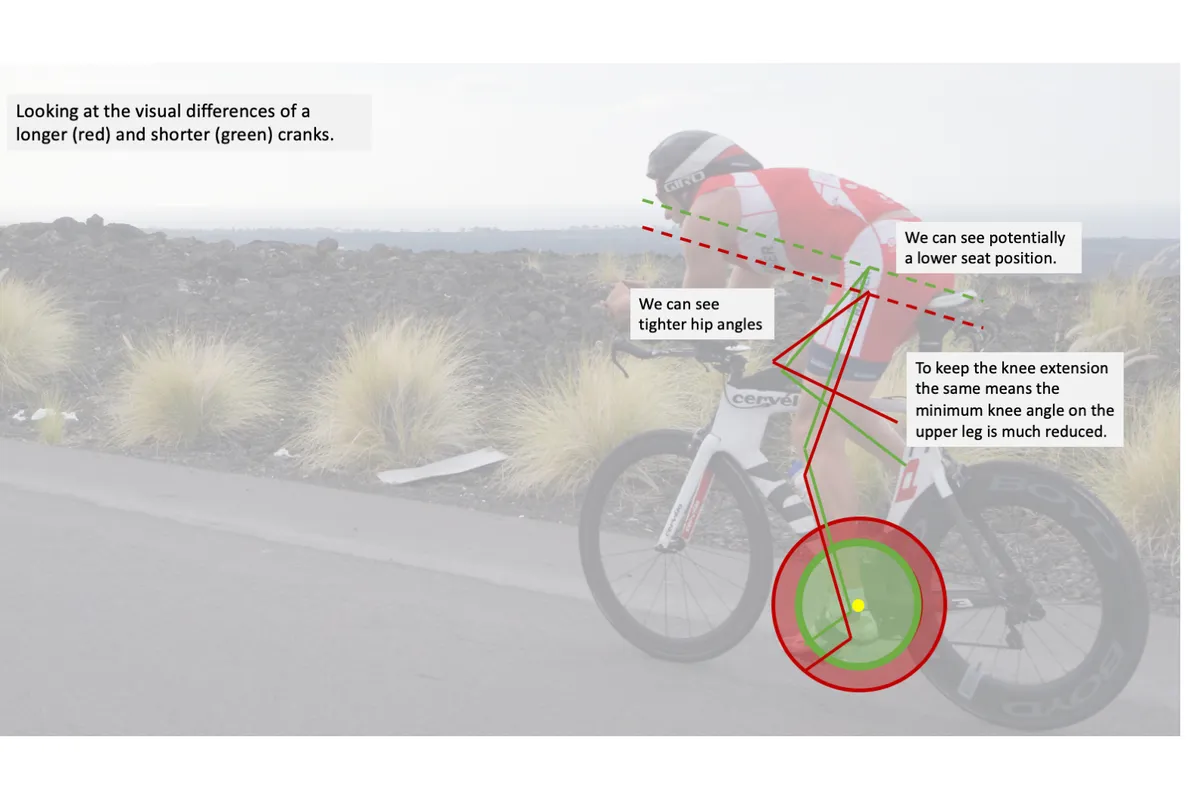Are you cycling with the right crank length? When triathletes buy a bike, they look to find the correct frame size. We all understand the concept that taller athletes need bigger frames and vice versa. However, just as crucial for a good bike fit is the crank arm length and few people consider this essential measurement.
- What’s the best bike set up for winter?
- Bike saddles: how to set yours up properly
- Behind the scenes of Alistair Brownlee TT bike fit
- What should be measured in a good triathlon bike fitting?
- What do bike gear ratios mean?
What is the crank length?
Crank length is the length from the centre of the bottom bracket to the centre of the pedal axle. Generally, most bikes are fitted with a 170-175mm crank, but the range can stretch from 140-190mm.
Why does crank length matter?
We have three touch points on the bike: saddle, handlebars and pedals. For most of us, we know when we get the saddle right or wrong (we usually find out the unpleasant way). We also recognise that saddle height affects bike position and, therefore, comfort and power. Some people may be aware of how the handlebars also impact your comfort on the bike. Female or smaller athletes will know that the handlebars position can make a huge difference to confidence and handling due to the ability to reach the brakes as well as grip width. Nevertheless, we all forget about the third part of the bike set up: the pedals and where they are attached to the crank arm.
Let’s first look at what the differences mean. The crank arm is the pedalling radius from the bottom bracket. A shorter pedal crank will make a smaller circle. The implication is that the foot won’t move so far up and down, i.e. there’s less range of motion for the leg to travel through. The range of movement will impact all the key leg joints: hip, knee and ankle. There are optimum ranges of motion for each of these joints depending on the bike you are on. In particular, keeping the hip angle as open as possible leads to improved power, usually better aerodynamics and, for triathletes, a better run off the bike.

From the image above, we have overlaid green to represent the current rider’s crank length and the red, the effect of longer cranks and the resultant positions. The text highlights the differences. To simplify the diagram above, there are no numbers for the angles. Observe when the same rider has longer cranks:
- Seat position – must be lower in order not to overextend the leg at the bottom of the pedal stroke
- Knee has to go higher at the top of the pedal stroke just to ‘get over’ the pedal
- The angle between the knee and the chest is reduced with the knee coming closer to the chest.
- To assist with this increased leg motion, the ankle is likely to move more to facilitate this movement. For cycling, this may make a limited difference and is a personal preference. For triathlon, the trend is to reduce movement and save the lower limb for the run!
The image is not drawn to any scale, so the lines are representative. We can see how a change in crank length can make a material difference to how the person sits on the bike even when they have the right sized frame.
Secondly, recall when you were in the gym doing a squat. Would you be able to lift more or less weight when you went deeper? Our bodies are most powerful when operating well within the range of our limbs. Keeping our hips open and our knees less flexed will usually generate more power or at least feel more comfortable generating the power.
Thirdly, longer cranks mean the foot goes deeper and higher. This will often translate to needing more control at the hip. Frequently, riders who “rock” at the hips are likely to be told to drop their saddle as the wisdom is that they are overreaching to the bottom of the pedal stroke. With their crankset too long for them, they may be struggling at the top of the pedal stroke and dropping the saddle will make things worse!
How do you work out the right crank length?
As with all talk about bike fit, these are personal changes. Personal flexibility, biomechanics and experience all impact any decision about changing crank length. Nevertheless, consider two different height riders: one is 180cm tall, the other is 160cm. If they each have the same crank length (172.5mm as an average), their foot will each rise 34.5cm (the top and bottom of the pedal stroke). For the taller rider, that is 19% of their height. For the shorter rider, that is 21.5%. Why is this important? Arguably, it’s not as it’s actually the leg length that will exaggerate the difference.
How long should my cranks be?
There are limited recommendations on how to select the best crank length other than knowing that the standard fit is 172.5 for a 180cm athlete. Jim Martin from the University of Utah suggests that the optimum should be about 20% of your inseam or 41% of your tibia length.
Another consideration of what to look at is the crank length compared to the saddle height to the bottom bracket. This ratio is likely to be specific to the rider but may help to normalise the differences between athletes. To date, there is no “standard” answer. With triathlon, the answer’s even more complicated as the bike is purely the vessel to get to the start of the run as quickly and effortlessly as possible.
Generally, if you are shorter (or wear shorter trousers for your height), you’re likely to want to consider a shorter crank arm.
Does a shorter crank length mean a loss of leverage?
“Give me a lever long enough, and a fulcrum on which to place it, and I shall move the world.”
– Archimedes
Power generated on the bike is the product of the speed we rotate the pedals and how hard we push on them. From our school science days, we learned about moments and levers and how a longer armed lever meant we could gain more of a moment with the same force. With a shorter pedal arm, the athlete will need to increase their cadence slightly to generate the same power. Still, the change in force is minimal at the extremely short crank arms. So the ability to “grind” out a bigger gear with longer arms has a negligible difference on performance.
Does the type of bike make a difference?
Given a TT bike’s position lowers you at the front, flattens your back and reduces the angle between your raised knee and your back, opening this angle as much as possible has a large number of benefits. Therefore, you are most likely to see aerodynamic and power gains by riding shorter cranks. On a road bike, due to the more relaxed or upright position, the difference will still exist but is less noticeable.
Ultimately, if a shortening of pedal cranks is going to lead to more comfort, better power transfer and better aerodynamics, then it will lead to more speed. If you are a shorter athlete, it is certainly worth considering this small change given the potential improvements.
Philip Hatzis is a BTF Level 3 qualified coach and Ironman certified coach
What should I be looking for in a second-hand bike?
When should I upgrade to a tri bike?
How much does bike weight influence speed?
